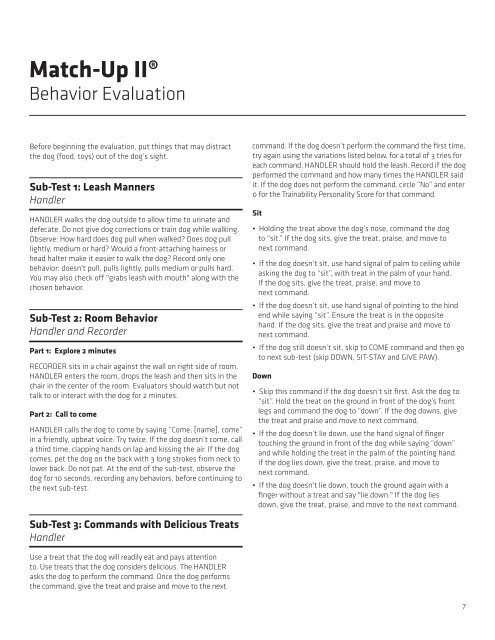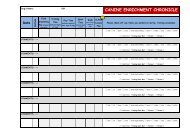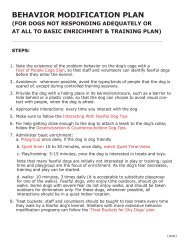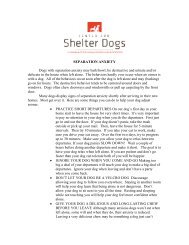Match-Up II Manual - Center for Shelter Dogs
Match-Up II Manual - Center for Shelter Dogs
Match-Up II Manual - Center for Shelter Dogs
- No tags were found...
Create successful ePaper yourself
Turn your PDF publications into a flip-book with our unique Google optimized e-Paper software.
<strong>Match</strong>-<strong>Up</strong> <strong>II</strong>®Behavior EvaluationBe<strong>for</strong>e beginning the evaluation, put things that may distractthe dog (food, toys) out of the dog’s sight.Sub-Test 1: Leash MannersHandlerHANDLER walks the dog outside to allow time to urinate anddefecate. Do not give dog corrections or train dog while walking.Observe: How hard does dog pull when walked? Does dog pulllightly, medium or hard? Would a front-attaching harness orhead halter make it easier to walk the dog? Record only onebehavior: doesn't pull, pulls lightly, pulls medium or pulls hard.You may also check off "grabs leash with mouth" along with thechosen behavior.Sub-Test 2: Room BehaviorHandler and RecorderPart 1: Explore 2 minutesRECORDER sits in a chair against the wall on right side of room.HANDLER enters the room, drops the leash and then sits in thechair in the center of the room. Evaluators should watch but nottalk to or interact with the dog <strong>for</strong> 2 minutes.Part 2: Call to comeHANDLER calls the dog to come by saying “Come, [name], come”in a friendly, upbeat voice. Try twice. If the dog doesn’t come, calla third time, clapping hands on lap and kissing the air. If the dogcomes, pet the dog on the back with 3 long strokes from neck tolower back. Do not pat. At the end of the sub-test, observe thedog <strong>for</strong> 10 seconds, recording any behaviors, be<strong>for</strong>e continuing tothe next sub-test.command. If the dog doesn’t per<strong>for</strong>m the command the first time,try again using the variations listed below, <strong>for</strong> a total of 3 tries <strong>for</strong>each command. HANDLER should hold the leash. Record if the dogper<strong>for</strong>med the command and how many times the HANDLER saidit. If the dog does not per<strong>for</strong>m the command, circle “No” and enter0 <strong>for</strong> the Trainability Personality Score <strong>for</strong> that command.Sit• Holding the treat above the dog’s nose, command the dogto “sit.” If the dog sits, give the treat, praise, and move tonext command.• If the dog doesn’t sit, use hand signal of palm to ceiling whileasking the dog to “sit”, with treat in the palm of your hand.If the dog sits, give the treat, praise, and move tonext command.• If the dog doesn’t sit, use hand signal of pointing to the hindend while saying “sit”. Ensure the treat is in the oppositehand. If the dog sits, give the treat and praise and move tonext command.• If the dog still doesn’t sit, skip to COME command and then goto next sub-test (skip DOWN, SIT-STAY and GIVE PAW).Down• Skip this command if the dog doesn’t sit first. Ask the dog to“sit”. Hold the treat on the ground in front of the dog’s frontlegs and command the dog to “down”. If the dog downs, givethe treat and praise and move to next command.• If the dog doesn’t lie down, use the hand signal of fingertouching the ground in front of the dog while saying “down”and while holding the treat in the palm of the pointing hand.If the dog lies down, give the treat, praise, and move tonext command.• If the dog doesn't lie down, touch the ground again with afinger without a treat and say "lie down." If the dog liesdown, give the treat, praise, and move to the next command.Sub-Test 3: Commands with Delicious TreatsHandlerUse a treat that the dog will readily eat and pays attentionto. Use treats that the dog considers delicious. The HANDLERasks the dog to per<strong>for</strong>m the command. Once the dog per<strong>for</strong>msthe command, give the treat and praise and move to the next7










